
In architecture, a hypostyle hall has a roof which is supported by columns.

Kasaba or Kasabaköy is a village in the Kastamonu District, Kastamonu Province, Turkey. Its population is 84 (2021). It is 17 kilometres outside Kastamonu, Turkey. It had a population of about 23,000 in 1905, when it had considerable local trade, but has since shrunk to only a few dozen households. Kasaba does not contain any ancient sites but does have an old mosque, the Mahmut Bey Camii, built by a representative of Isfendiyarid dynasty in the second half of the 14th century.
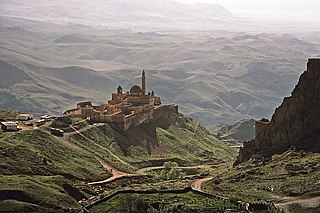
Ishak Pasha Palace is a semi-ruined palace and administrative complex located in the Doğubeyazıt district of Ağrı province of eastern Turkey.

Divriği Great Mosque and Hospital was built in 1228–1229 by the local dynasty of the Mengujekids in the small Anatolian town of Divriği, now in Sivas Province, Turkey. The complex is in the upper town, below the citadel. The exquisite stone carvings and eclectic architecture of the complex places it among the most important works of architecture in Anatolia and led to its inclusion on UNESCO's World Heritage List in 1985.

Turkish art refers to all works of visual art originating from the geographical area of what is present day Turkey since the arrival of the Turks in the Middle Ages. Turkey also was the home of much significant art produced by earlier cultures, including the Hittites, Ancient Greeks, and Byzantines. Ottoman art is therefore the dominant element of Turkish art before the 20th century, although the Seljuks and other earlier Turks also contributed. The 16th and 17th centuries are generally recognized as the finest period for art in the Ottoman Empire, much of it associated with the huge Imperial court. In particular the long reign of Suleiman the Magnificent from 1520 to 1566 brought a combination, rare in any ruling dynasty, of political and military success with strong encouragement of the arts.
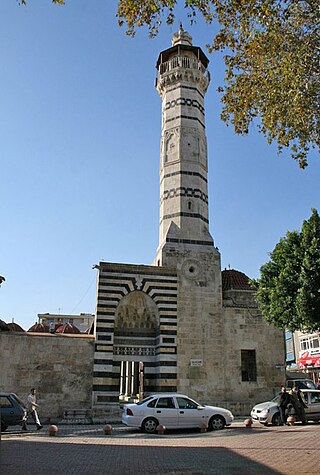
The Great Mosque of Adana, also known as the Ramazanoglu Mosque, is a mosque from the 16th century in Adana, Turkey. It forms part of a complex (külliye) that includes a madrasah and a mausoleum (türbe). The complex is on Kızılay Street, next to the Ramazanoğlu Hall.

The Grand Mosque of Bursa is a historic mosque in Bursa, Turkey. It was commissioned by the Ottoman Sultan Bayezid I to commemorate his great victory at the Battle of Nicopolis and built between 1396 and 1399. The mosque is a major monument of early Ottoman architecture and one of the most important mosques in the city, located in the heart of the old city alongside its historic markets.

The Üç Şerefeli Mosque is a 15th-century Ottoman mosque in Edirne, Turkey.

Youssef Dey Mosque, also known as Al B'chamqiya, is a 17th-century mosque in Tunis, Tunisia, located in Medina area of the city. The mosque is considered significant as it was the first Ottoman mosque to be built in Tunis.

Anatolian Seljuk architecture, or simply Seljuk architecture, refers to building activity that took place under the Sultanate of Rum, ruled by an offshoot of the Seljuk dynasty that emerged from the Great Seljuk Empire alongside various other local dynasties. The Anatolian Seljuks patronized their own tradition of architecture whose surviving examples are generally found in present-day Turkey. Anatolian Seljuk architecture was eclectic and influenced by multiple traditions including Armenian, Byzantine, Iranian, and Syrian architecture. Unlike earlier Great Seljuk architecture to the east, their buildings were generally constructed in stone and featured significant stone-carved decoration as well as tile decoration. While the Seljuk Sultanate declined and ended in the late 13th century, architecture continued to flourish and diversify under the smaller Beylik states in Anatolia, which included the early Ottomans.

Eşrefoğlu Mosque is a 13th-century mosque in Beyşehir, Konya Province, Turkey It is situated 100 metres (330 ft) north of the Beyşehir Lake
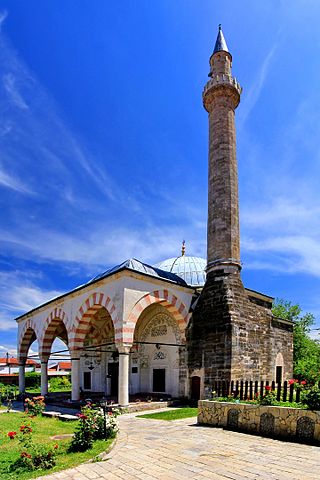
The Hadum Mosque in Gjakova, Kosovo was built in the last decade of the 16th century (1594/95) and was financed by Hadum Sylejman Efendia – Hadum Aga, which explains the name of the mosque. The mosque was built on the property of Jakë Vula and is located in the Old Bazaar. Evliya Çelebi said that around the plain of Jak Vula and Hadum Mosque were 2000 houses, some masjid and two monumental mosques, inns covered in lead, a beautiful hamam and 300 shops.

İskender Pasha Mosque, a.k.a. Terkim Masjid is a historic mosque located in Fatih district in Istanbul, Turkey.
Kastamonu Ethnography Museum is a museum in Kastamonu, Turkey

Sivrihisar Grand Mosque is a historical mosque in Sivrihisar, Turkey.

The Afyon Grand Mosque is a historical mosque in Afyonkarahisar in Afyonkarahisar province, Turkey.

The Great Mosque of Sivas is a historic mosque located in Sivas, Turkey. It was built in the 12th century and is the oldest surviving building in the city. Its minaret was built in the early 13th century.
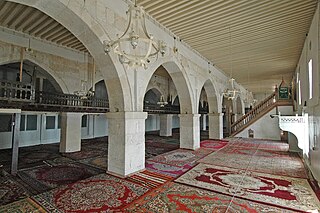
Ermenek Grand Mosque is located on the outskirts of Ermenek Castle on an outcrop that overlooks the city of Ermenek. The mosque was built by Mahmud Bey of the Karamanids in 1302AD (702AH), as inscribed in Sülüs-style calligraphy on the original door wings between the antechamber and the prayer hall.
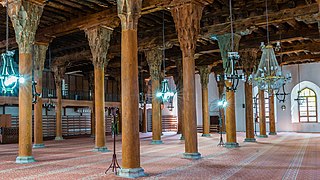
The Wooden Hypostyle Mosques of Medieval Anatolia are a World Heritage Site consisting of five Seljuk mosques in Anatolia dating back to the late 13th and mid-14th centuries.


































